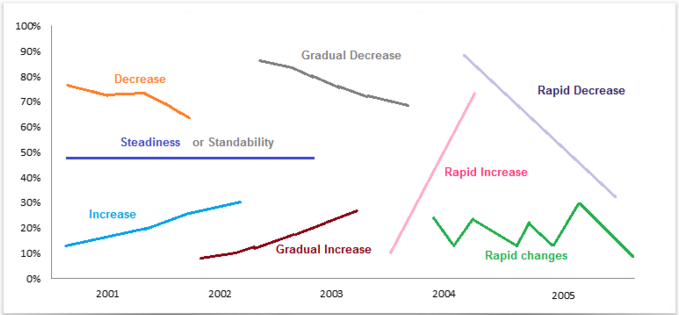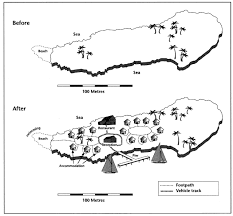Để viết bài Writing task 1 chúng ta sẽ phải so sánh giữa các hạng mục dữ liệu trong biểu đồ rất nhiều. Do đó các bạn cần nắm được các quy tắc biến đổi từ, cách sử dụng tính từ, liên từ biểu thị so sánh…, ngoài ra cần có vốn từ vựng khá để miêu tả với đa dạng từ ngữ.
Dưới đây mình sẽ liệt kê một số quy tắc và cách dùng từ cơ bản, các bạn lưu ý nhé.
1. Nhắc lại một số quy tắc so sánh:
Đối với từ có một âm tiết:
big » bigger » biggest || high » higher » highest || low » lower » lowest….
Lưu ý một số từ bất quy tắc như: good » better » best || bad » worse » worst etc.
Hai âm tiết:
pretty » prettier » prettiest || happy » happier » happiest …
Lưu ý các trường hợp bất quy tắc, thêm ‘more’:
striking » more striking » most striking || common » more common » most common || clever » more clever/cleverer » most clever/cleverest …
Ba và lớn hơn ba âm tiết: sử dụng ‘more’ & ‘most’:
attractive » more attractive » most attractive || profitable » more profitable » most profitable || expensive » more expensive » most expensive…
2. So sánh giữa các câu:
Cách thức cơ bản để miêu tả so sánh là bắt đầu câu với từ/cụm từ biểu hiện rằng sẽ bạn sẽ làm một so sánh với câu/các câu đã viết trước đó. Một số từ cơ bản là:
In contrast
The most popular form of holiday among the Welsh was self-catering with over 60% choosing to cook for themselves. In contrast, only 5 % of the English chose this form of vacation and hotel accommodation was much more popular at 48%.
In comparison
Almost 50% of the English, Scots and Northern Irish chose to stay in a hotel for their holiday. In comparison, staying in self-catering accommodation was much less popular with around 10% of people choosing this.
However
The general pattern was for hotel accommodation to be the most popular with around half the people choosing it. The majority of the Welsh, however, chose to stay in self-catering accommodation.
On the other hand
It is clear that a majority of the British chose to stay in hotel for their holiday. On the other hand, there was an exception to this because over 50% of the Welsh opted for self-catering accommodation.
Lưu ý:
– Dấu phẩy thường được thêm vào sau ‘In contrast’ ‘In comparison’ ‘On the other hand’.
– Có rất nhiều cách khác để miêu tả sự so sánh và đây chỉ là những cách cơ bản nhất.
3. So sánh trong câu:
Một cách cơ bản khác là so sánh các thông tin được nêu ra trong cùng một câu. Một số từ cơ bản hay được sử dụng là:
while
While there are 4 million miles of train lines in the UK, there are only 3 million in France.
whereas
Whereas the majority of the French prefer to travel to work by train, only a small minority of the British do.
although
Although 15% of the French read novels, only 5% of the British do.
but
Almost 25% of French females study maths with a private tutor, but nearly 60% study English with one.
4. So sánh với more hay less/fewer:
Khi sử dụng cách này chúng ta chú ý một số điểm ngữ pháp sau
Than
Sau more/less/fewer cần có than
Five percent more girls chose to read books than go to cinema.
Fewer/less : Less cho danh từ không đếm được, fewer cho danh từ đếm được:
Fewer mobiles phones were bought in 2013 than 2014.
Less oil was consumed in 2013 than 2014.
5. Nêu rõ hơn về sự chênh lệch với các trạng từ hay con số:
Khi sử dụng less/more/fewer để so sánh chúng ta có thể cần nêu rõ hơn về sự khác biệt bằng cách sử dụng thêm các trạng từ như

E.g.
This month criminal growth of the city is slightly larger than the previous month.
This month criminal grown is almost twice than 2014.
Sale of the shop has increased quite a lot this quarter.
Hoặc cũng có thể thêm vào các con số để cho phần so sánh được cụ thể:
Far fewer people chose to travel by train than by car. [Thiếu chi tiết]
Twenty – five percent fewer people chose to travel by train than by car. [không chỉ so sánh mà còn có chi tiết cụ thể]
6. So sánh với most hay least/fewest:
Khi làm so sánh, các điểm lớn nhất và nhỏ nhất cũng là các thành phần quan trọng mà chúng ta cần nêu ra.
The most popular form of entertainment in the UK was going to the cinema.
The least common form of transport was taking a taxi.
7. So sánh với similar hay same hay as…as:
Similar (to)
The percentages of females and males who studied languages at university were very similar.
A similar amount of gas and electricity was used domestically in homes.
The figures for 2012 were very similar to the figures for 2013.
Same as …as
USA makes as much money as UK but not as much as China.
The percentage of females who studied at university in 2011 was almost exactly the same as in 2012.
8. So sánh với differ/different/difference
The amount of time spent at home differed by almost 25% according to gender.
There was a difference of over 25% in the amount of time males and females spent at home.
This figure was very different among males, only half of whom watched television.
9. So sánh với con số:
Ngoài việc nêu rõ các con số cụ thể, trong so sánh chúng ta cũng có thể miêu tả sự chênh lệch gấp nhau bao nhiêu lần.
[5 million] more/less/fewer
Five million fewer units of gas were sold in 2014.
Twice
Twice as many people elected to use gas and not electricity for cooking [note the twice as …as structure]
Twice the amount of gas was used for cooking in this period. [note that we amount with uncountable nouns]
Three/four etc times
Four times as many people chose to heat their house with electricity as with gas.
Half
Half the number of people chose to use gas as electricity.
Electricity was half as popular as gas for cooking.
10. Một số từ vựng khác về so sánh:

Lưu ý sử dụng từ vựng:
1. On the contrary >< In contrast to:
– On the contrary: 2 vế đối lập KHÔNG CÙNG tồn tại. Vế sau nhấn mạnh, làm rõ chi tiết hơn vế trước.
e.g., 1. The test will not be easy; on the contrary, it will be extremely difficult.
e.g., 2. There was no malice in her; on the contrary, she was very kind
( cô ấy không có ác ý gì, mà ngược lại, cô ấy lại rất tốt bụng)
– In contrast to: 2 vế khác biệt có thể CÙNG tồn tại
e.g., His current friendly manner is in marked contrast to his usual behavior.
(Thái độ thân thiện hiện bây giờ của anh ấy khác với thái độ bình thường)
Như trên, nếu bạn không chắc về cách viết thì không nên dùng “on the contrary” khi miêu tả các chi tiết khác nhau hay đối lập nhau trong biểu đồ, nhưng bạn có thể dùng “in contrast to“.
Phần từ vựng về so sánh này đều có thể áp dụng trong các dạng câu hỏi Tables, Bars, Lines, Pies, Maps, Process của Ielts writing Task 1 nhé.
Bài hướng dẫn này bao gồm các tài liệu mình tổng hợp trên Internet với nguồn chính là dcielts.com.
Mình mong rằng nó sẽ giúp ích được cho các bạn trong việc ôn luyện để đạt được mục tiêu Ielts.
With love & passion
P/s: Ngoài những bài giảng online cho người tự học Ielts, nếu muốn học kỹ và chất lượng hơn với các lớp học ít người, học phí thấp các bạn có thể tham gia các lớp luyện thi Ielts offline trên đường Nguyễn Trãi – Hà Nội của mình nhé.
CÁC KHÓA HỌC OFFLINE CỦA Ms. NGÂN HOA
Hướng dẫn các kỹ năng Ielts:
Luyện thi tốt nghiệp THPT & ĐH









